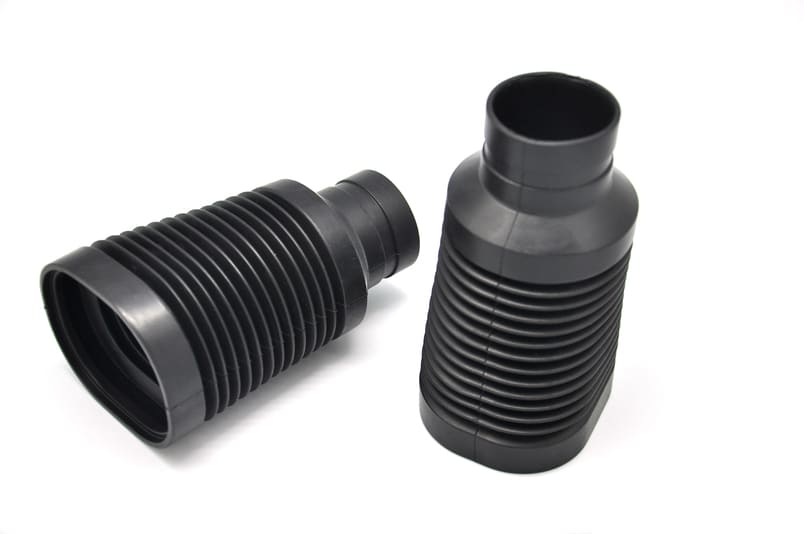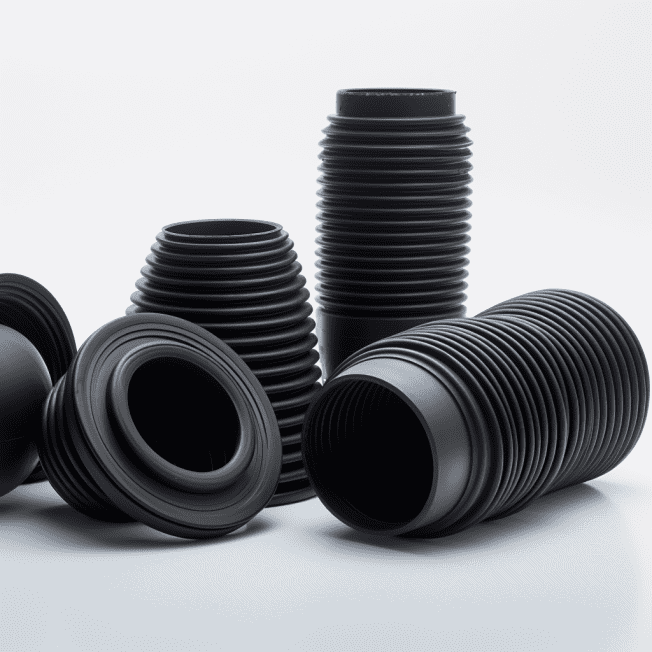Rubber bellows are flexible, accordion-like components used to cover, protect, and seal machinery and equipment. They are essential for a variety of applications across different industries. But what exactly are rubber bellows used for?
Rubber bellows are commonly used to protect components from dust, moisture, and debris, as well as to provide sealing and flexibility in machinery, particularly in environments with high movement or vibration.

Rubber bellows1 are widely used in various industries, from automotive to industrial machinery. Their versatility and durability make them indispensable in protecting sensitive components and maintaining the efficiency of equipment. Let’s take a deeper look into what rubber bellows are, their codes, types, and their advantages and disadvantages.
What is a Rubber Bellow?
What exactly is a rubber bellow? Rubber bellows are flexible, cylindrical components made from elastomers like rubber, designed to expand and contract without losing shape. They are often used to provide protection against environmental factors or to absorb movement and vibration.
A rubber bellow is a flexible, accordion-shaped seal made from rubber that protects machinery from contaminants, absorbs movement, and reduces noise and vibration.
Rubber bellows are made of durable rubber material that allows them to stretch and contract, making them suitable for a variety of applications. They are typically used to cover moving parts of machinery, such as shafts, rods, or pistons, to prevent dust, dirt, and moisture from entering while also providing cushioning. Their accordion-like design allows them to expand and contract without compromising the seal.
Key Features of Rubber Bellows
- Flexibility2: They can expand and contract to accommodate movement.
- Durability: Made from rubber compounds that offer resistance to wear and tear.
- Protection: Shields machinery from contaminants, such as dust, debris, and moisture.
- Noise Reduction: Helps in reducing noise and vibration caused by mechanical components.
What is the HS Code for Rubber Bellow?
The HS (Harmonized System) code for rubber bellows is crucial for international trade, as it helps classify products for customs and import/export purposes. Rubber bellows are classified based on their material, design, and application.
The HS code for rubber bellows typically falls under the broader category for rubber products, specifically under section 40 of the Harmonized System, which covers rubber and articles thereof.
The exact HS code for rubber bellows3 may vary depending on the specific type of bellow and the material used. Typically, rubber bellows are classified under HS code 4009, which includes other rubber products, but it’s important to consult with your country’s customs authority4 or a freight forwarder5 to ensure you have the correct code for your product.
Common HS Codes for Rubber Bellows
| Product Description | HS Code |
|---|---|
| Rubber bellows (general use) | 4009.11 |
| Rubber bellows (for machinery) | 4009.12 |
| Reinforced rubber bellows | 4009.19 |
Note that the HS code can vary based on factors such as whether the rubber bellow is reinforced or molded in a specific way. Custom classifications may be necessary if the bellow has unique features or applications. Always confirm with your local customs office to ensure you’re using the right code for accurate duty and tax calculation.
In summary, the HS code for rubber bellows3 generally falls under section 4009, but verifying with your country's regulations is essential for smooth international trade.
What Are the Different Types of Rubber Bellows?
Rubber bellows come in various types, each designed for different applications. The design and materials vary based on the function they need to perform, such as sealing, vibration isolation, or movement accommodation.
The most common types of rubber bellows are cylindrical bellows, conical bellows, and molded bellows, each suited for different mechanical requirements.

Types of Rubber Bellows
Cylindrical Bellows: The most common type, featuring a straight and uniform design. They are used in applications requiring linear motion, such as protecting rods or shafts in machinery.
Conical Bellows: These bellows have a tapered design and are often used where space constraints require a more compact bellow. They are typically used in telescopic applications.
Molded Bellows: These are custom-made bellows designed for specific applications, often molded to fit a particular shape or size. They offer superior sealing properties and can be made from a variety of rubber materials.
Common Materials for Rubber Bellows
| Material Type | Key Characteristics | Common Applications |
|---|---|---|
| EPDM | Excellent weather and UV resistance | Outdoor machinery, HVAC |
| NBR | Good oil and fuel resistance | Automotive, industrial |
| Silicone | High-temperature resistance | High-heat environments |
| Neoprene | Good abrasion resistance | General industrial use |
What Are the Advantages and Disadvantages of Rubber Bellows?
Like any product, rubber bellows have both advantages and disadvantages. Understanding these can help in selecting the right type of bellow for a specific application.
Rubber bellows offer high flexibility, excellent protection, and durability, but they can be prone to wear under harsh conditions and may require regular maintenance.
Advantages of Rubber Bellows
Flexibility and Movement Accommodation: Rubber bellows can handle a significant amount of movement, making them ideal for dynamic applications where parts need to expand and contract.
Protection Against Contaminants: They protect sensitive components from dust, debris, moisture, and other harmful environmental factors.
Noise and Vibration Reduction: Rubber bellows help reduce noise and vibration in machinery, improving comfort and performance.
Durability: Rubber bellows are made from materials that are resistant to wear and tear, making them long-lasting in most industrial environments.
Disadvantages of Rubber Bellows
Wear and Tear: Over time, rubber bellows can degrade due to exposure to high temperatures, UV light, and chemicals.
Limited Temperature Range: While some rubber materials are heat-resistant, rubber bellows in general may not be suitable for extremely high or low temperatures.
Maintenance: In some applications, rubber bellows may need to be replaced regularly due to wear or environmental exposure.
| Advantages | Disadvantages |
|---|---|
| Flexibility and durability | Susceptible to wear |
| Effective protection | Limited temperature range |
| Noise reduction | Regular maintenance needed |
Conclusion
Rubber bellows play a vital role in protecting machinery from contaminants, absorbing vibration, and allowing flexibility in moving parts. While they offer many advantages, it's essential to consider the specific application and material properties to ensure optimal performance.
Explore this link to understand the diverse applications of rubber bellows across industries, enhancing your knowledge of their importance. ↩
Discover how the flexibility of rubber bellows contributes to machinery efficiency and longevity, making it a crucial aspect to consider. ↩
Understanding the HS code for rubber bellows is essential for accurate customs classification and smooth international trade. Explore this link for detailed insights. ↩ ↩
Consulting your customs authority ensures compliance with regulations and avoids costly mistakes in international shipping. Check this resource for guidance. ↩
Freight forwarders are key in navigating international shipping regulations, including HS codes. Learn more about their role and how they can assist you. ↩







